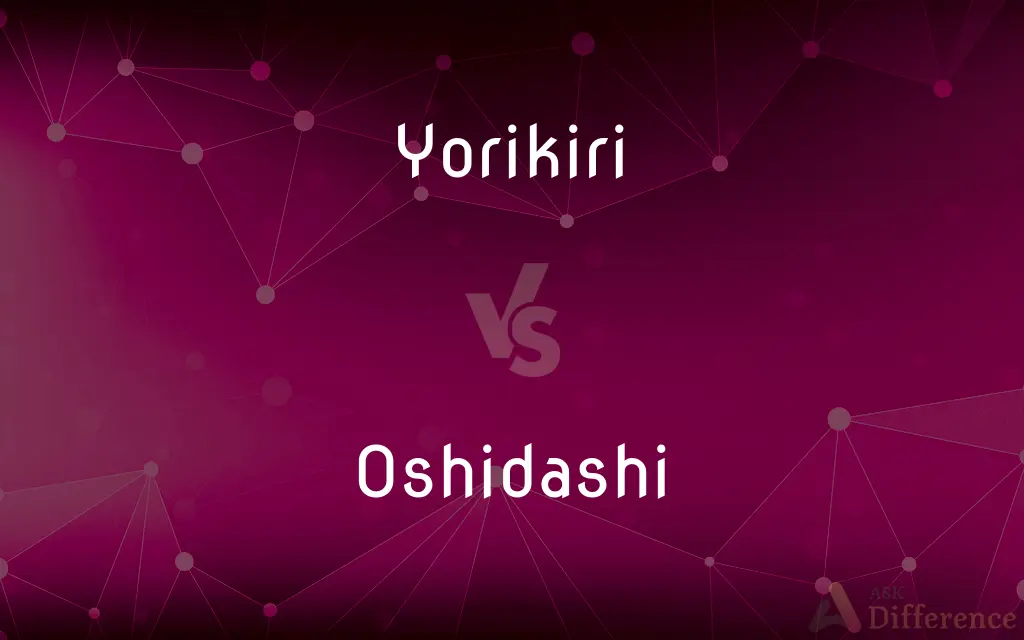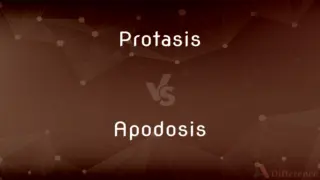Yorikiri vs. Oshidashi — What's the Difference?
Edited by Tayyaba Rehman — By Urooj Arif — Updated on April 15, 2024
Yorikiri, a sumo technique, involves forcing an opponent out of the ring by gripping their belt, while Oshidashi is pushing them out without a belt grip.

Difference Between Yorikiri and Oshidashi
Table of Contents
ADVERTISEMENT
Key Differences
Yorikiri focuses on establishing a strong grip on the opponent's belt to control and move them steadily out of the ring. On the other hand, Oshidashi involves direct pushing techniques, where the wrestler uses hands on the opponent’s body to drive them backwards.
In Yorikiri, the wrestler must maintain close contact, leveraging body position and grip to execute the move effectively. Whereas, Oshidashi requires more straightforward force and momentum, prioritizing upper body strength and stability.
The strategic approach in Yorikiri is often slower and more methodical, aiming for a secure hold before proceeding. Conversely, Oshidashi tends to be more dynamic and aggressive, seeking to overpower the opponent quickly.
Yorikiri is considered a more classical and technical sumo technique, reflecting a wrestler's skill in maneuvering and balance. Oshidashi, on the other hand, showcases physical power and the ability to dominate spatially in the ring.
Wrestlers proficient in Yorikiri often excel in endurance and technique, able to adapt to their opponent's moves. In contrast, those who favor Oshidashi typically benefit from explosive strength and quick decision-making.
ADVERTISEMENT
Comparison Chart
Grip
Requires belt grip
No belt grip required
Technique Focus
Control and maneuvering
Force and momentum
Strategy
Methodical and strategic
Aggressive and dynamic
Skill Reflection
Technique and balance
Strength and spatial control
Typical Wrestler Trait
Endurance, technique adaptation
Explosive strength, quick action
Compare with Definitions
Yorikiri
In Yorikiri, maintaining a secure belt grip is essential for control.
His Yorikiri was effective due to his unbreakable grip.
Oshidashi
This move is characterized by its direct and forceful approach.
An explosive Oshidashi ended the match quickly.
Yorikiri
Yorikiri is often a display of technical skill rather than mere strength.
He won by Yorikiri, showcasing superior technique.
Oshidashi
Oshidashi is a technique in sumo wrestling where a wrestler pushes an opponent out of the ring without a belt grip.
He secured the victory through a powerful Oshidashi.
Yorikiri
Yorikiri is a sumo wrestling technique where a wrestler forces an opponent out of the ring while holding their belt.
The match concluded with a classic Yorikiri move.
Oshidashi
Oshidashi is preferred by wrestlers who are physically robust and aggressive.
His aggressive style is perfect for Oshidashi.
Yorikiri
The strategy in Yorikiri involves gradual positioning and movement.
He executed a slow but unstoppable Yorikiri.
Oshidashi
Oshidashi requires strong upper body force and quick movement.
His Oshidashi was driven by sheer upper body strength.
Yorikiri
Wrestlers who excel in Yorikiri often have high stamina and strategic acumen.
His stamina allowed him to perform Yorikiri effectively.
Oshidashi
Success in Oshidashi depends on the ability to overpower quickly.
His quick action and power made his Oshidashi unbeatable.
Yorikiri
(sumo) A kimarite in which the attacker drives his opponent out backwards while maintaining a constant grip on his mawashi.
Oshidashi
(sumo) a kimarite in which the attacker pushes his opponent out of the ring, maintaining hand contact at all times
Common Curiosities
Which technique shows more technical skill, Yorikiri or Oshidashi?
Yorikiri typically shows more technical skill, involving strategic grip and maneuver.
What is the main goal of Yorikiri in sumo wrestling?
The main goal is to force the opponent out of the ring while maintaining a belt grip.
Does Yorikiri require more strategy than Oshidashi?
Yes, Yorikiri generally requires more strategy related to positioning and grip compared to the more straightforward Oshidashi.
Can a sumo wrestler use Oshidashi at any point during the match?
Yes, a wrestler can use Oshidashi whenever they can overpower the opponent with force.
Is Yorikiri considered more effective than Oshidashi?
Effectiveness depends on the wrestler’s skill set; Yorikiri can be more effective for those skilled in technique and endurance.
How does Oshidashi differ from Yorikiri in terms of contact?
Oshidashi involves pushing the opponent without needing to grip the belt.
What physical attributes benefit a wrestler using Oshidashi?
Physical strength, especially in the upper body, and quick reflexes are crucial for executing effective Oshidashi.
What is the risk of using Oshidashi in a sumo match?
The main risk is the possibility of losing balance or missing the push, which can leave the attacker vulnerable to counter-attacks.
How does the choice between Yorikiri and Oshidashi reflect a wrestler's training focus?
Wrestlers trained in technical grappling and endurance might lean towards Yorikiri, while those focusing on strength and quick attacks might prefer Oshidashi.
In what situations is Oshidashi most effective?
Oshidashi is most effective when the opponent is off-balance or less prepared to resist a forward push.
Which type of wrestler typically prefers Yorikiri?
Wrestlers who excel in technical grappling and have good endurance typically prefer using Yorikiri.
How important is speed in executing Oshidashi successfully?
Speed is very important in Oshidashi, as the wrestler needs to quickly overpower and push out the opponent.
Can Yorikiri be used against any size opponent?
Yes, Yorikiri can be effective against any size opponent, but the technique and approach might vary depending on the opponent's size and strength.
Share Your Discovery

Previous Comparison
Protasis vs. Apodosis
Next Comparison
Animism vs. PantheismAuthor Spotlight
Written by
Urooj ArifUrooj is a skilled content writer at Ask Difference, known for her exceptional ability to simplify complex topics into engaging and informative content. With a passion for research and a flair for clear, concise writing, she consistently delivers articles that resonate with our diverse audience.
Edited by
Tayyaba RehmanTayyaba Rehman is a distinguished writer, currently serving as a primary contributor to askdifference.com. As a researcher in semantics and etymology, Tayyaba's passion for the complexity of languages and their distinctions has found a perfect home on the platform. Tayyaba delves into the intricacies of language, distinguishing between commonly confused words and phrases, thereby providing clarity for readers worldwide.














































